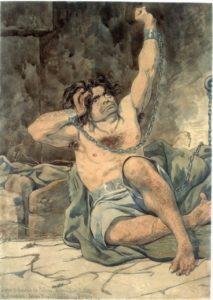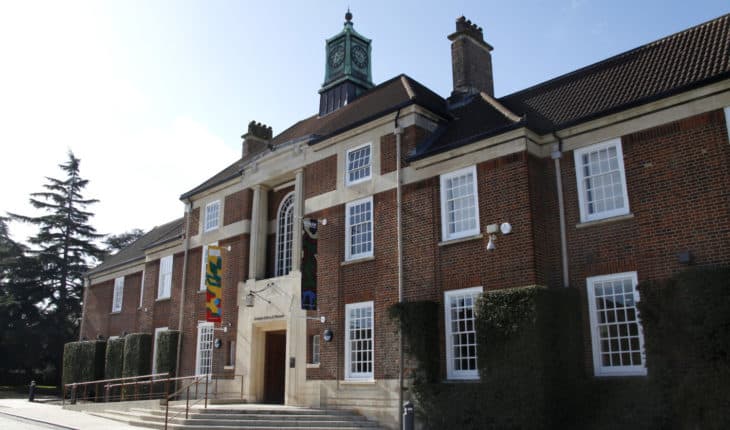Rebecca Wallersteiner looks at The Passions of Richard Dadd Revisited at the Bethlem Museum of the Mind, (the original Bedlam), until 27th November 2021, which examines the disturbing, powerful art of former ‘Bedlam’ patient Richard Dadd, who suffered from a form of paranoid schizophrenia.

Richard Dadd’s ‘Agony – Raving Madness’ – Bethlem Museum of the Mind
‘For artist Richard Dadd, the passions were not merely emotions, preoccupations or hobbies. They were the instincts that drove behaviour, kept in check only by social expectations and the internal moderators of human reason and conscience,’ explains Colin Gale, Director of Bethlem Museum of the Mind, in Beckenham. Until 27th November, this intriguing, small museum is presenting an exhibition of paintings by the artist Richard Dadd. Opened in 2015, the museum is housed in an elegant Art Deco building shared with the Bethlem Gallery, which hosts exhibitions of contemporary artists who are current or former patients. The museum is based in the original ‘Bedlam’ Bethlem Royal Hospital which was England’s first asylum for the treatment of mental illness and for many years notorious for its inhumane conditions, the nickname of which – Bedlam – became associated with madness or chaos. It was also a popular London attraction for the morbidly disposed. Richard Dadd was Bedlam’s most notorious former patient.
A promising artist who specialised in supernatural subjects, such as fairies and orientalist scenes, Dadd became so convinced that his father was the devil in disguise that he murdered him with a sailor’s knife in the summer of 1843. Detained in ‘Bedlam’ as a ‘criminal lunatic’ he continued to paint furiously during his incarceration and is now acclaimed as one of the Victorian era’s most accomplished artists. Dadd probably suffered from a form of paranoid schizophrenia. There seems to have been a family genetic disposition to the illness as two of his siblings had similar symptoms. In Bedlam he was encouraged to paint and was able to his most celebrated paintings including 33 watercolour drawings titled Sketches to Illustrate the Passions, which include Love, Jealousy as well as Murder and Agony-Raving Madness – all created on a small scale.
After twenty years at Bethlem, Dadd was transferred to the criminal lunatic asylum at Broadmoor, where he remained painting constantly and receiving occasional visitors until he died from lung disease, in 1886. He continues to exert a fascination over other artists and musicians, including the singer the late Freddie Mercury, a former art student, who was inspired to write the song ‘The Fairy Feller’s Master-Stroke’ based on Dadd’s painting, which he had seen at the Tate Gallery.
‘Dadd’s series of sketches on the passions, completed while a secure hospital patient in the 1850s, provides comment on the human condition that is insightful, empathetic and cryptic, all at the same time,’ observes Gale. Bethlem’s museum’s collections are rich in works by artists who, in common with Richard Dadd, but not necessarily inspired by him, have represented the passions that motivate us. In the exhibition, each of the Bethlem passion pictures has been paired with a work which opens up another perspective on Dadd’s chosen subjects.
Another highlight in the exhibition, thanks to the kind support of the Arts Promotion Centre Finland (TAIKE), is Panu Ollikainen’s The Dance of Time hanging alongside Richard Dadd’s Sketch to illustrate Insignificance. In this haunting, thought-provoking installation, tiny wire figures run, pirouette, or are dragged around on their hands and feet by the unceasing march of time, as if to highlight the fragility of mortal life and unanswerable questions of the meaning of life.
Founded in 1247, Bethlem Royal Hospital was the first institution in England to specialise in care of the mentally ill. Based in the original ‘Bedlam’ the Bethlem Museum of the Mind contains historic and contemporary works of art by artists who have suffered from a mental disorder. Entering the elegant art deco building, the visitor ascends the grand art-deco staircase passing the renowned statues of ‘Raving’ and ‘Melancholy’ madness which originally stood above the gates of the 17th hospital. The museum’s permanent displays includes works by artists who have suffered from mental health problems such as former patients William Kurelek and Louis Wain. Other exhibits illustrate the history of mental healthcare.
Visiting the museum is a wonderful way to spend a winter afternoon, especially for people interested in medical history, art and those involved in care of the mentally ill.
The Passions of Richard Dadd Revisited at the Bethlem Museum of the Mind, until 27th November 2021,
Bethlem Royal Hospital, Monks Orchard Road, Beckenham, Kent BR3 3BX
Opening hours : Wednesdays, Thursdays and Fridays 10am to 5pm and on the first and last Saturdays of each month from 10am to 5pm, FREE ENTRY
Access to the museum’s archives is by appointment only.

Panu Ollikainen’s ‘The Dance of Time’ – Bethlem Museum of the Mind
- People’s Choice Victory for Down’s Syndrome Scotland Garden at Chelsea 2025 - 28th May 2025
- Cadogan: A Chelsea Family By Tamsin Perrett - 3rd May 2025
- Dream Worlds a new exhibition in Cambridge - 14th December 2024







